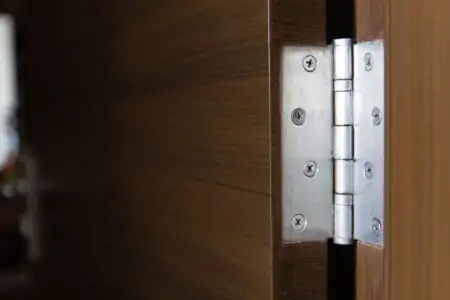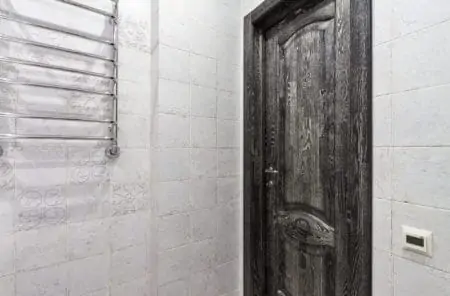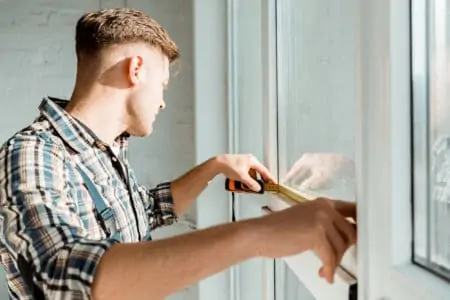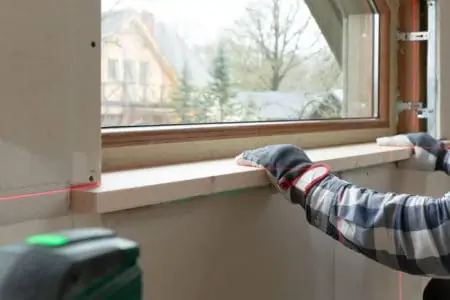Squeaky door hinges aren’t just for creepy houses in horror movies. The doors in your home will squeak at some point, so knowing how to fix a squeaky door hinge is useful. It occurs when the hinges rub together, which increases wear and tear.
We show you how to fix squeaking hinges with lubricant and tell you which one is the best to use.
Key Takeaways
- Squeaky door hinges occur when hinges rub together, causing friction and wear.
- Popular lubricants for fixing squeaks include silicone spray, lithium grease, and paraffin wax.
- Alternative lubricants are hairspray, furniture polish, and olive oil.
- Regular lubrication (every 6 months to a year) can help prevent squeaky door hinges.
Why Do Doors Squeak?
While it could be wood rubbing on wood making that annoying noise, it is most likely the hinges that are creaky. They gather dust and debris as they age, stopping the hinges from moving freely. This causes metal to rub on metal.
Best Lubricant for Squeaky Door Hinges
So, your door has developed a squeak, and it makes you cringe every time it opens. What are your options when seeking a solution? Lubricant is the obvious choice, but which one should you choose?
Silicone Spray
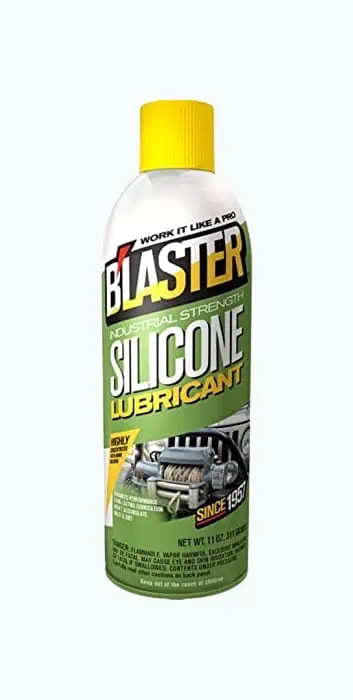
Silicone spray, like this B’laster Industrial Strength Lubricant, is a great option for loosening rusted or squeaky hinges. It is widely available and easy to use. Plus, it doesn’t contain mineral oils and grease.
Lithium Grease
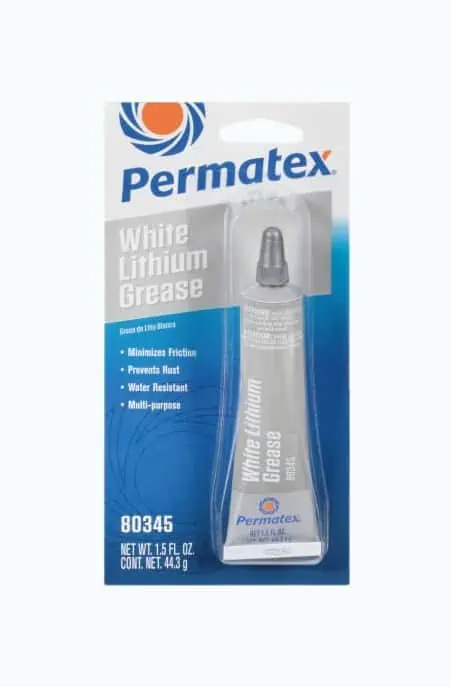
Lithium grease, like this PermatexWhite Lithium Grease, fixes noisy hinges. Place one small blob on the top of the hinge pin and work the door back and forth as the lubricant penetrates the hinge. This is an excellent way to fix that squeaky hinge without taking it apart.
GT85
GT85 is an excellent home remedy for noisy hinges. This Finish Line Bike lubricant contains Teflon and comes in small cans to minimize wastage. One small squirt inside your hinges removes dirt and adds a lubricating layer, so it moves freely.
Paraffin Wax

Paraffin wax, like this Blended Wax Paraffin Block, contains petroleum, which helps to lubricate your hinges. The process is more involved because you must melt the wax and pour it over the removed hinge pin.
Once inserted back in place, it should move without squeaking.
Hairspray
When you finish styling your hair, that can of hairspray is an ideal solution for fixing your noisy hinges without removing them. The force of the spray penetrates the gaps in the hinge and lubricates it. You should only use this method for short-term fixes.
Furniture Polish
No products found.
Furniture polish by well-known brands like Pledge works wonders on hinges. Spray it into the hinge and work the door back and forth until the polish penetrates the gaps. However, using furniture polish is not a long-term solution.
Bar Soap
Rubbing soap onto your squeaky hinges helps loosen the mechanism, so it moves freely. Soap contains palm and coconut oils and has been used for thousands of years as a lubricant. And the bonus is you get sweet-smelling door hinges.
Top Tip
Organic brands are the best to use because they contain a higher fat content.
Petroleum Jelly

Petroleum jelly is found in many products, from hair gels to moisturizers, so it should work miracles on your squeaky hinges. Use this Vaseline Lip Therapy Stick because it comes in a handy tube, making it easy to use.
Olive Oil
Drop some olive oil into a pipette, add a few drops to your hinges, and hey presto! The squeak is gone.
Vaseline
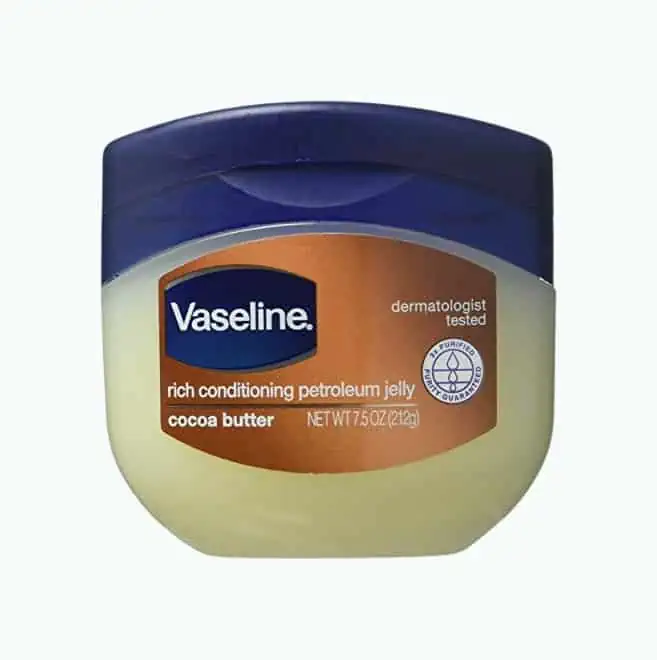
Vaseline may be great for moisturizing chapped lips and dry skin, but it is also amazing for lubricating your stiff door hinges. Smear it on and move the door back and forth to help the vaseline work its way into the hinge mechanism.
Why Not WD-40?
You’re probably wondering why WD-40 hasn’t featured on the list. While it is a popular method of lubricating rusty or squeaky hinges, it isn’t the best product to use in the long run.
WD-40 is a cleaning agent containing small amounts of lubricant, but it is also a water displacer. So while it greases in the short-term, it possibly attracts more dust and debris. This can cause your hinges to squeak even more.
We get that WD-40 is by far the most popular method of lubricating stuck hinges, but it isn’t necessarily the best.
How to Fix Squeaky Door Hinges Without WD-40
Before you reach for that well-known can of lubricant (be honest and admit you were), there are far better long-term solutions than WD-40. As we said, WD-40 is primarily a water displacer rather than a lubricant, so you could be making things worse.
Before you start lubricating your hinge (behave yourself!), giving it a thorough clean is advisable. Remove the hinge pin and use some soapy water and steel wool to clean the pin.
It is also worth grabbing a nylon pipe cleaner, like this set of Long Straw Brushes, and insert inside the barrel where the hinge pin sits. This removes any debris lodged inside.
So, if not WD-40, then what should you use?
Olive Oil
1. Lubricate the Hinge Without Removing It
Olive oil is a great way to lubricate the hinge without removing it. The best way to administer the oil is to use a pipette. Add a couple of drops to the top of the hinge, covering the pin.
Swing the door from side to side to let the oil seep into the barrel of the hinge.
2. Remove the Pin
If the squeak doesn’t go using the first method, you will need to remove the pin. Shut the door and find the base of the pin. Grab a hammer and a nail, and gently tap out the pin.
When it is free enough to pull out by hand, remove it and place it somewhere safe. With the door unattached, lean it against the wall for stability.
3. Coat the Pin in Olive Oil
Take the pin and wipe it clean with a paper towel, ensuring all the dirt is gone. Pour a small amount into a glass and dip the pin to ensure a generous coating with oil.
4. Drop the Pin Back In
Push the pin into the top of the hinge, ensuring that the door is lined up. If this is tricky on your own, get someone to hold the door steady while you tap the pin down using the nail and hammer.
Test the door for squeaks by swinging it from side to side several times.
Easy Tip
If you are working on your own, you could always grab a screwdriver and remove the hinge from the door frame. That way, you don’t have to balance the door, making the task simpler.
With Petroleum Jelly
1. Try Lubricating Without Removing the Pin
Smear the petroleum jelly over the surface of the hinge, taking particular care to coat the gaps and the top of the hinge pin. Move the door back and forth to work the jelly into the hinge, and the squeak should disappear.
If the noise persists, try moving to the second step.
2. Remove the Pin
Using the same technique as before, pull the pin out from the hinge. While the pin is free, it is a good idea to check the hinge for trapped debris. Also, grab a paper towel and wipe the pin to clean the surface.
Smear the petroleum jelly over the pin and slide it back into the housing. Use the hammer and nail if the pin needs some persuasion.
3. Wipe Away the Excess Petroleum Jelly
With the pin in place, grab another paper towel and wipe away the excess petroleum jelly. Now test the door to see if the squeak has gone.
With Vaseline
1. Try for the Quick Fix
As before, try loading the hinge with vaseline to see if the hinge stops squeaking without the need to remove it. Smear it liberally over the entire hinge, taking care to push it into the gaps.
2. Remove the Hinge Pin
Using the nail and hammer method, tap the hinge pin free. Wipe the hinge pin with a clean rag or paper towel to clean away the dirt. Now, smear it with vaseline using your fingers, and wipe the excess away with a paper towel.
Top Tip
While the pin is out of the hinge, grab a pipe cleaner or long straw brush and insert it into the empty hinge chamber. It’s a great way to remove the debris inside to stop the hinge from squeaking.
3. Replace the Pin
Gently tap the pin back in place using the hammer and nail. As the pin descends into the hinge chamber, it pushes the excess vaseline out of the top. Use a clean rag to wipe away the residue.
With Paraffin Candle Wax
1. Try Lubricating Without Removing the Hinge Pin
If you can get rid of the squeak without removing the hinge pin, it will make your life easier. Take the paraffin wax candle and rub it against the hinge, pushing the wax deep into the hinge mechanisms.
Try the door, and if the noise has gone, you’ve just saved yourself from performing a more in-depth job. If not, move to the second stage.
2. Remove the Hinge Pin
Tap the hinge pin out using the hammer and nail and place it somewhere safe. The door comes away from the hinge bracket when you remove the pin. To keep it safe, lean the door against a wall.
3. Melt the Paraffin Wax
Cut off a small chunk of the candle and drop it into a small microwaveable dish. Melt the paraffin in the microwave for between one and two minutes until it is completely melted.
If you don’t have a microwave, you can use a saucepan and an electric stove to perform this task.
Important Point
Don’t heat the candle wax on a gas stove because it releases vapors. These vapors could ignite near naked flames.
4. Coat the Hinge Pin
Hold the hinge pin over a paper plate and pour the melted wax over, ensuring you coat the shaft of the pin.
5. Replace the Pin
Pop the pin back into the hinge, taking care to line up the door. Gently tap it in place using the hammer and nail. Again, get someone to hold the door while you do this if you struggle.
Now test the door to see if the squeak has gone. If you still have a squeak, rub more wax onto the hinge.
Keep In Mind
You may need to coat the pin several times before you get success. Also, while you would normally wipe away the excess, this method requires keeping the wax in situ.
How Often Should You Oil a Door Hinge?
Because hinges consist of moving parts, it is recommended that you treat them with lubricant every six months to a year. If the door is in a high-traffic area, you may need to do it every two or three months.
FAQs
Don’t Freak Over That Squeak
All door hinges make a noise from time to time; the secret is to keep them lubricated, so they stay operational for as long as possible. However, if you’ve tried everything we’ve suggested and your hinges are still bringing you grief, you may need to buy new hinges.
The good news is they are inexpensive and easy to replace.
